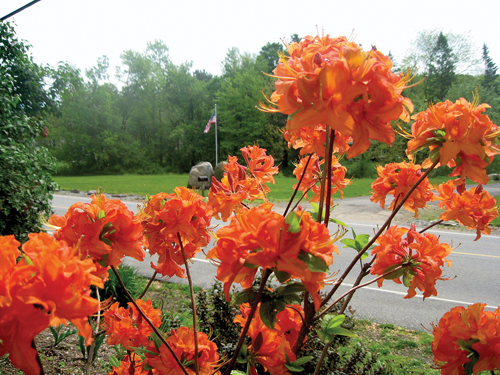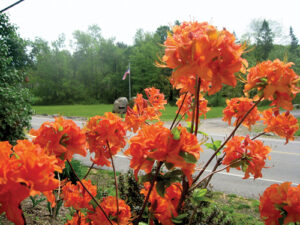

By Ann Needle
Tuesday’s cold slop likely made many folks yearn for the warm weather to arrive, bringing with it the opportunity to get back into the garden. The Stow Garden Club was a step ahead of this demand last Thursday, hosting a public presentation at Town Hall on this year’s trends in gardening.
About 20 gardeners and hopefuls listened to Stow resident John Link, a tree and shrub buyer at Russell’s Garden Center in Wayland, talk about what’s trending in Native American plants this year, peppered with advice on how to protect these plants around the yard.
First, Link got the bad news out of the way. “I don’t know how many of you grew impatiens last year, and they all died,” Link said, mentioning that a disease was responsible. He estimated that Russell’s has gone from six greenhouses to about half a greenhouse for these flowers. Because the disease is expected to linger into this season, he warned, “Don’t buy them.” (However, he added that New Guinea impatiens have been fine.) Instead, some of the flowers Link suggested includes lobelia, begonias, and “fabulous” coleus that grows in sun and shade, and comes in a variety of colors.
Also, Link reported that the first of the winter moths have appeared around Sudbury, though he has yet to see them in this area. Their babies are tiny, green, and hang from threads off the trees — “and they are voracious,” Link warned. “You want to be vigilant NOW.” He cautioned that these babies once wiped out all the trees on Massachusetts Ave. in the center of Newton. Dormant oil will suffocate them, but Link stressed that it must be sprayed up the trunk thoroughly, not just at the base. He mentioned that Spinosad Spray is most effective against the babies.
And, when Link mentioned deer as a common bane among Stow gardeners, the “ohs” were quite audible. Link distributed a list of about 80 plants that range from “very rarely” to “occasionally” damaged by nibbling deer. Meanwhile, Link agreed that one way to drive away the pests is to hang fragrant bath soaps — such as Coast and Irish Spring — off of nearby trees. Link also offered that Milorganite fertilizer seems to work well.
But, be warned: Link maintained, “Coyote urine is a waste of money.”

Ann Needle
Azaleas and Beyond
The stalwarts of local planters continue to gain in popularity, some with a new twist. “Everyone wants azaleas,” Link commented. “Deer love azaleas.” The azaleas’ popularity means humans have more than 70 varieties to choose from at Russell’s, Link mentioned.
Hydrangeas also are appearing in more local gardens, with Link claiming he has 13 in his own yard. Among hydrangeas, Link declared the “Forever and Ever” a personal favorite, a double-blooming plant that turns blue earlier in the season, and, in September, a “gorgeous, deep burgundy color.” For those with lots of sun, Link said Fire and Ice hydrangeas could work out well. These also change color with the seasons, starting out white in the spring and deepening to burgundy in the fall.
Among the long list of new and potentially popular plants to consider is a variegated abelia, which Link tagged as easier to take care of than regular abelias. Japanese maples continue to show up in different varieties, 47 currently available in every color variation and leaf thickness.
A Miss Molly butterfly bush (aka “summer lilac”) now comes in a “fluorescent, fluorescent pink; you can see them at the end of the block,” Link said.
For those really hungering for a taste of warm weather, “Everyone should consider having a paw paw in their yard – tastes like a banana,” Link observed. And yes, figs can grow here with care, he added.